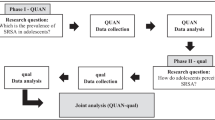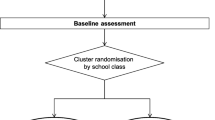Abstract
The aim of this study was to explore the suitability of a Christian 12-step program based on a biblical perspective for smartphone-addicted adolescents. The study found that “repentance” and “realizing ones’ calling” were the main similarities between the 12-step program’s core principles and biblical themes. Based on a biblical analysis the 12 step program however features some limitations, including an ambiguous definition of the “great power”, a superficial understanding of sin, and a need to consider adolescents’ characteristics. This study suggests the following strategies: (1) diagnosis of adolescents’ image of God and transformation of this image into a biblical image of God, (2) intervention regarding sin through a holistic perspective, (3) adolescents’ recognition of their own calling, and (4) an adult counselor working to trigger social learning in 12 steps. Finally, for application within Christian counselling, the study suggests a cognitive therapeutic approach based on a biblical image of God and a systematic evaluative process of sin in addicted adolescents.

Similar content being viewed by others
References
Ahn, K. S. (2010). Addiction and faith community. Journal of Counseling and Gospel, 15, 105–133.
Ahn, E. S. (2013). A study on the christian counseling method for the restoration of god-image of codependents. Journal of Counseling and Gospel, 21, 156–189.
Akos, P., Hamm, J. V., Mack, S. G., & Dunaway, M. (2007). Utilizing the developmental influence of peers in middle school groups. The Journal for Specialists in Group Work, 32(1), 51–60. https://doi.org/10.1080/01933920600977648.
Alcoholics Anonymous World Services. (2001). Alcoholics Anonymous: The Story of How Many Thousands of Men and Women have Recovered from Alcoholism (4th ed.). NewYork: Alcoholics Anonymous World Services Inc.
American Psychiatric Association. (2013). Diagnostic and statistical manual of mental disorders (DSM-5®). American Psychiatric Pub. https://doi.org/10.1176/appi.books.9780890425596.
Beck, A. T. (1979). Cognitive Therapy of Depression. New York: Guilford press.
Bonhoefer, D. (1954). Life together (J. W. Doberstein, Trans.) New York: Harper& Row.
Bristow-Braitman, A. (1995). Addiction recovery: 12-step programs and cognitive- behavioral psychology. Journal of Counseling and Development, 73(4), 414–418. https://doi.org/10.1002/j.1556-6676.1995.tb01774.x.
Burlingame, G. M., McClendon, D. T., & Alonso, J. (2011). Cohesion in group therapy. In J. C. Norcross (Ed.), Psychotherapy relationships that work: Evidence-based respon siveness (2nd ed., pp. 110–131). New York: Oxford University Press.
Calvin, John. (2008). Institutes of the Christian Religion. Kissimmee: Signalman Publishing.
Cheung, C. K., & Ngai, S. S. Y. (2016). Reducing deviance through youths’ mutual aid group dynamics. International Journal of Offender Therapy and Comparative Criminology, 60(1), 82–98. https://doi.org/10.1177/0306624X14548024.
Chi, F. W., Kaskutas, L. A., Sterling, S., Campbell, C. I., & Weisner, C. (2009). Twelve-step affiliation and 3-year substance use outcomes among adolescents: Social support and religious service attendance as potential mediators. Addiction, 104(6), 927–939. https://doi.org/10.1111/j.1360-0443.2009.02524.x.
Choi, E. M., & Kim, M. S. (2016). The effect of motivational interview oriented and cognitive behavioral group counseling for college students with smartphone addiction. Korean Journal of Counseling, 17(3), 169–185.
Corey, M. S., Corey, G., & Corey, C. (2013). Groups: Process and Practice. Boston: Cengage Learning.
Craigie, F. C., Jr., & Tan, S. Y. (1989). Changing resistant assumptions in Christian cognitive-behavioral therapy. Journal of Psychology and Theology, 17(2), 93–100. https://doi.org/10.1177/009164718901700201.
Crews, F., He, J., & Hodge, C. (2007). Adolescent cortical development: a critical period of vulnerability for addiction. Pharmacology, Biochemistry and Behavior, 86(2), 189–199. https://doi.org/10.1016/j.pbb.2006.12.001.
Dies, K. (2000). Adolescent development and a model of group psychotherapy: Effective leadership in the new millennium. Journal of Child and Adolescent Group Therapy, 10, 97–110. https://doi.org/10.1023/A:1009426722846.
Dossett, W. (2013). Addiction, spirituality and 12-step programmes. International Social Work, 56(3), 369–383. https://doi.org/10.1177/0020872813475689.
Enez Darcin, A., Kose, S., Noyan, C. O., Nurmedov, S., Yılmaz, O., & Dilbaz, N. (2016). Smartphone addiction and its relationship with social anxiety and loneliness. Behaviour & Information Technology, 35(7), 520–525. https://doi.org/10.1080/0144929X.2016.1158319.
Erikson, E. H. (1993). Childhood and Society. New York: WW Norton & Company.
Freud, S. (2003). Totem and Taboo. London: Routledge.
Gamble, J., & O’lawrence, H. (2016). An overview of the efficacy of the 12-step group therapy for substance abuse treatment. Journal of Health and Human Services Administration, 39(1), 142–160.
Gao, T., Xiang, Y. T., Zhang, H., Zhang, Z., & Mei, S. (2017). Neuroticism and quality of life: Multiple mediating effects of smartphone addiction and depression. Psychiatry Research, 258, 457–461. https://doi.org/10.1016/j.psychres.2017.08.074.
Gray, T. M., & Rubel, D. (2018). “Sticking together”: the adolescent experience of the cohesion process in rural school counseling groups. The Journal for Specialists in Group Work, 43(1), 35–56.
Grudem, W. (1999). Bible Doctrine: Essential Teachings of the Christian Faith. Grand Rapids: Zondervan.
Guinness, O. (1998). The Call. Nashville: Word Publishing.
Hoekema, A. A. (1994). Saved by Grace. Grand Rapids: W. B. Eerdmans Publishing Company.
Ji, M. K., Kim, Y. M., & Kim, S. Y. (2017). The structural relationships among sports activity engagement, emotional inteeligence, smartphone addiction and antisocial tendency for adolescents. The Korean Journal of Physical Education, 56(3), 271–282.
Kaskutas, L. A., Bond, J., & Humphreys, K. (2002). Social networks as mediators of the effect of Alcoholics Anonymous. Addiction, 97(7), 891–900. https://doi.org/10.1046/j.1360-0443.2002.00118.x.
Keller, T. (2011). Counterfeit Gods: The Empty Promises of Money, Sex, and Power, and the Only Hope that Matters (p. 2009). New York: Penguin Books.
Keller, T., & Alsdorf, K. L. (2014). Every Good Endeavor: Connecting Your Work to God’s Work. New York: Penguin Books.
Kelly, J. F., Brown, S. A., Abrantes, A., Kahler, C. W., & Myers, M. (2008). Social recovery model: An 8-year investigation of adolescent 12-step group involvement following inpatient treatment. Alcoholism, Clinical and Experimental Research, 32(8), 1468–1478. https://doi.org/10.1111/j.1530-0277.2008.00712.x.
Kernberg, O. (1985). Borderline Conditions and Pathological Narcissism. Lanham: Rowman & Littlefield Publishers.
Kézdy, A., Martos, T., & Robu, M. (2013). God image and attachment to god in work addiction. Studia Psychologica, 55(3), 209–214.
Kim, D., Lee, Y., Lee, J., Nam, J. K., & Chung, Y. (2014). Development of Korean smartphone addiction proneness scale for youth. PLoS ONE, 9(5), 1–8. https://doi.org/10.1371/journal.pone.0097920.
Kim, H. S., & Park, S. G. (2015). Qualitative study about recovery experience of gambling addict through participation in GA. The Korean Journal of Health Psychology, 20(1), 111–138.
Lee, S. J., & Rhee, M. K. (2016). Effect of personalities and use motivations of smartphone users on smartphone addiction. The Korean Journal of Health Psychology, 21(2), 357–372.
Lovelace, R. F. (1979). Dynamics of spiritual life: an evangelical theology of renewal. Downers Crove: InterVarsity Press.
McGrath, J., & McGrath, A. E. (2002). Self-Esteem: The Cross and Christian Confidence (p. 2002). Wheaton: Crossway.
Mehdizadeh, S. (2010). Self-presentation 2.0: narcissism and self-esteem on facebook. Cyberpsychology, Behavior, and Social Networking, 13(4), 357–364. https://doi.org/10.1089/cyber.2009.0257.
Ministry Science and ICT, National Information Society Agency (2018). Korea Smartphone overuse in 2017. Retrived from http://www.msit.go.kr/web/msipContents/contentsView.do?cateId=mssw11241&artId=1384077.
Moos, R. H. (2008). Active ingredients of substance use-focused self- help groups. Addiction, 103(3), 387–396. https://doi.org/10.1111/j.1360-0443.2007.02111.x.
Packer, J. I. (2011). Knowing God. London: Hodder & Stoughton.
Park, S. K., Kang, S. K., Kim, K. H., Seo, K. H., Shin, S. M., Lee, H. C., et al. (2009). Theories and Practices of Addiction Counseling. Seoul: Hakjisa.
Piaget, J. (1951). Play, Dreams, and Imitation in Childhood. New York: Norton.
Piper, J. (2004). When I don’t Desire God: How to Fight for Joy. Wheaton: Crossway.
Powlison, D. (1999). X-ray questions: Drawing out the whys and wherefores of human behavior. The Journal of Biblical Counselling, 18(1), 2–9.
Rizzuto, A. (1979). The Birth of Living God: Psychoanalytic Study. Chicago: University of Chicago Press.
Salovey, P., & Mayer, J. D. (1990). Emotional Intelligence. Imagination, Cognition and Personality, 9(3), 185–211. https://doi.org/10.1017/CBO9780511806582.019.
Samaha, M., & Hawi, N. S. (2016). Relationships among smartphone addiction, stress, academic performance, and satisfaction with life. Computers in Human Behavior, 57, 321–325. https://doi.org/10.1016/j.chb.2015.12.045.
Shim, J. Y. (2016). Christian counselling’s study and approach based on Rizzuto’s God’s Image Theory. Journal of Counseling and Gospel, 24(2), 183–219.
Shim, J. Y. (2017a). Christian spirituality’s dynamics influencing Christian adolescent smartphone addiction: Based on the Korean Brief Version of God’s Image Scale (Unpublished doctoral dissertation). Seoul: Chongshin University.
Shim, J. Y. (2017b). Christian counseling approach to adolescent narcissism relating to online game addiction - based on otto Kernberg`s theory. Journal of Counseling and Gospel, 25(1), 117–151.
Smith, A. (2015). U. S. Smartphone use in 2015. Retrieved from http://www.pewinternet.org/2015/04/01/us-smartphone-use-in-2015/.
The Holy Bible. (2017). Christian standard bible. Nashville: Holman Bible Publishers.
Timmons, S. M. (2012). A Christian faith-based recovery theory: Understanding God as sponsor. Journal of Religion and Health, 51(4), 1152–1164.
Welch, E. T. (1994). Who are we? need, longings, and the image of god in man. The Journal of Biblical Counseling, 13(1), 25–38.
Welch, E. T. (2001). Addictions, a banquet in the grave: finding hope in the power of the gospel, resources for changing lives. Phillipsburg: Presbyterian & Reformed.
Yalom, I. D., & Leszcz, M. (2005). The theory and practice of group psychotherapy (5th ed.). New York: Basic Books.
Yu, H. G., & Son, C. (2016). Effects of ACT on smartphone addiction level, self- control, and anxiety of college students with smartphone addiction. Journal of Digital Convergence, 14(2), 415–426. https://doi.org/10.14400/JDC.2016.14.2.415.
Acknowledgement
This work was supported by the National Research Foundation of Korea (Grant Number 2017S1A5B5A01026138).
Author information
Authors and Affiliations
Corresponding author
Ethics declarations
Conflict of interest
The authors declare that they have no conflict of interest.
Informed content
All participants agree with the informed content to involve this study.
Additional information
Publisher's Note
Springer Nature remains neutral with regard to jurisdictional claims in published maps and institutional affiliations.
Rights and permissions
About this article
Cite this article
Shim, J.Y. The study of a Christian 12-Step Program for Christian Smartphone-Addicted Adolescents: A Biblical Perspective. J Relig Health 60, 1780–1795 (2021). https://doi.org/10.1007/s10943-020-01170-w
Accepted:
Published:
Issue Date:
DOI: https://doi.org/10.1007/s10943-020-01170-w




